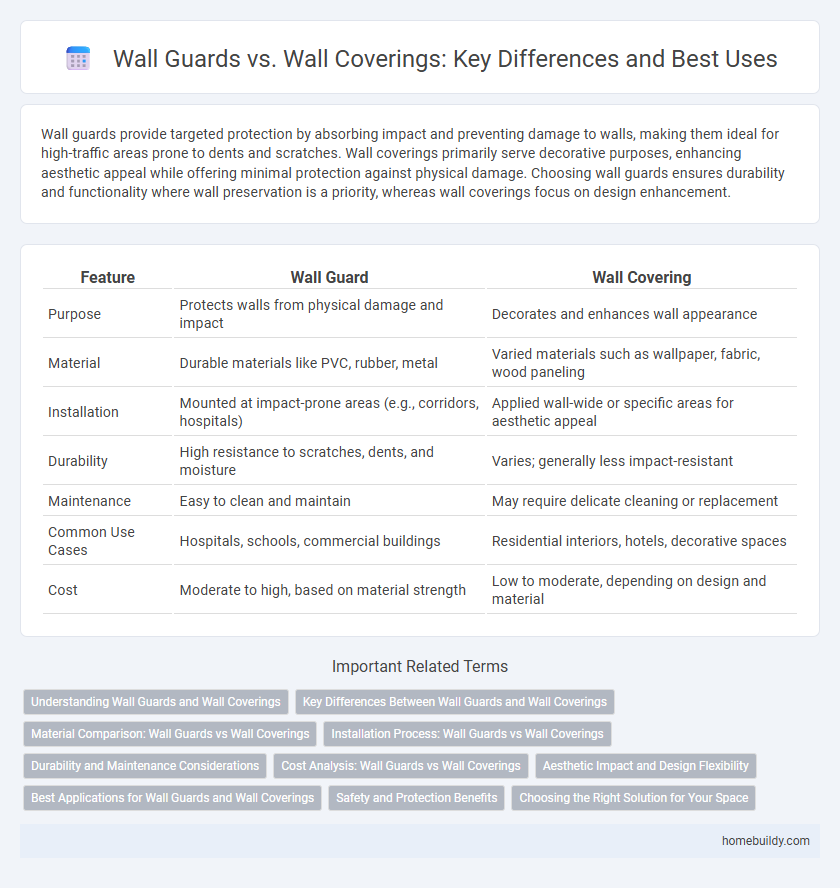Wall guards provide targeted protection by absorbing impact and preventing damage to walls, making them ideal for high-traffic areas prone to dents and scratches. Wall coverings primarily serve decorative purposes, enhancing aesthetic appeal while offering minimal protection against physical damage. Choosing wall guards ensures durability and functionality where wall preservation is a priority, whereas wall coverings focus on design enhancement.
Table of Comparison
| Feature | Wall Guard | Wall Covering |
|---|---|---|
| Purpose | Protects walls from physical damage and impact | Decorates and enhances wall appearance |
| Material | Durable materials like PVC, rubber, metal | Varied materials such as wallpaper, fabric, wood paneling |
| Installation | Mounted at impact-prone areas (e.g., corridors, hospitals) | Applied wall-wide or specific areas for aesthetic appeal |
| Durability | High resistance to scratches, dents, and moisture | Varies; generally less impact-resistant |
| Maintenance | Easy to clean and maintain | May require delicate cleaning or replacement |
| Common Use Cases | Hospitals, schools, commercial buildings | Residential interiors, hotels, decorative spaces |
| Cost | Moderate to high, based on material strength | Low to moderate, depending on design and material |
Understanding Wall Guards and Wall Coverings
Wall guards are protective devices installed to prevent damage to walls caused by impact, commonly used in high-traffic areas such as hospitals and commercial buildings. Wall coverings, by contrast, serve primarily decorative and aesthetic purposes, including materials like wallpaper, fabric, or vinyl that enhance the appearance of interior spaces. Understanding the functional difference between wall guards and wall coverings is essential for selecting the appropriate solution based on durability needs versus design preferences.
Key Differences Between Wall Guards and Wall Coverings
Wall guards are designed primarily to protect walls from physical damage, often made from durable materials like rubber, vinyl, or plastic to absorb impacts in high-traffic areas. Wall coverings, including wallpaper, fabric, and decorative panels, focus on aesthetic enhancement and surface decoration rather than protection. The key difference lies in functionality: wall guards provide a defensive barrier against scratches and dents, while wall coverings improve visual appeal without significant protective benefits.
Material Comparison: Wall Guards vs Wall Coverings
Wall guards are typically made from durable materials such as PVC, rubber, or aluminum designed to protect walls from impact and abrasion, whereas wall coverings often consist of decorative materials like vinyl, fabric, or wallpaper focused on aesthetics rather than protection. The impact resistance and easy maintenance of wall guards make them ideal for high-traffic areas, while wall coverings prioritize visual appeal and texture diversity. Material choice directly affects functionality, with wall guards providing robustness and longevity, contrasting with the decorative emphasis of wall coverings.
Installation Process: Wall Guards vs Wall Coverings
Wall guards typically require a straightforward installation involving secure mounting with screws or adhesive directly onto the wall surface, ensuring durable protection against impacts. Wall coverings, such as wallpaper or fabric panels, often demand more precise surface preparation, including cleaning and priming, followed by careful alignment and smoothing to avoid bubbles or wrinkles. The installation of wall guards is generally quicker and more durable in high-traffic areas compared to wall coverings, which may require periodic maintenance or replacement.
Durability and Maintenance Considerations
Wall guards offer superior durability compared to traditional wall coverings, as they are specifically designed to withstand impact, scratches, and daily wear in high-traffic areas. Maintenance of wall guards typically involves simple cleaning with mild detergents, requiring less frequent replacement or repair than standard wall coverings that may peel, stain, or fade over time. Choosing wall guards enhances long-term protection and reduces upkeep costs, making them ideal for commercial and healthcare environments.
Cost Analysis: Wall Guards vs Wall Coverings
Wall guards typically offer a more cost-effective solution compared to wall coverings due to their durable materials and lower maintenance requirements. While wall coverings may incur higher initial expenses and frequent replacement costs, wall guards provide long-term savings by preventing damage and reducing repair needs. Budget-conscious projects favor wall guards for their balance of protection and affordability in high-traffic areas.
Aesthetic Impact and Design Flexibility
Wall guards offer superior protection while maintaining sleek aesthetics that blend seamlessly with various interior designs, unlike traditional wall coverings which may prioritize appearance over durability. The design flexibility of wall guards enables customization in materials, colors, and profiles to complement architectural styles and enhance spatial harmony. This balance of form and function makes wall guards an ideal choice for environments demanding both visual appeal and robust wall protection.
Best Applications for Wall Guards and Wall Coverings
Wall guards are best applied in high-traffic areas such as hospitals, schools, and commercial buildings where protection against impact and damage is crucial. Wall coverings excel in aesthetic enhancement and moisture resistance, making them ideal for decorative purposes in residential and hospitality interiors. Choosing between wall guards and wall coverings depends on prioritizing durability and protection versus design and finish quality.
Safety and Protection Benefits
Wall guards provide targeted impact resistance to protect walls from damage in high-traffic or equipment-intensive areas, significantly reducing repair costs and maintaining structural integrity. Wall coverings primarily enhance aesthetic appeal and may offer limited durability but do not provide the robust protection against dents, scratches, or abrasions that wall guards deliver. Installing wall guards in commercial or healthcare settings ensures enhanced safety by preventing wall damage that can lead to contamination or hazardous debris.
Choosing the Right Solution for Your Space
Wall guards provide durable protection against impact and abrasion in high-traffic areas, making them ideal for commercial and healthcare environments where wall damage is frequent. Wall coverings enhance aesthetic appeal and add texture or color but typically offer less resistance to physical damage compared to wall guards. Selecting the right solution depends on balancing durability needs with design goals to ensure long-lasting protection without compromising style.
Wall guard vs Wall covering Infographic

 homebuildy.com
homebuildy.com